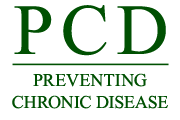PCD News Summary for September 14, 2017

Notice to News Media – PCD Release Time and Embargo Policy:
CDC’s News Media Branch releases to reporters the PCD media packet every Tuesday afternoon between 12 and 2 pm.
Embargoed until Thursday, September 14, at 12:00 PM ET
Construction of a North American Cancer Survival Index to Measure Progress of Cancer Control Efforts
A national cancer survival index (CSI) could be used to measure time-based progress in meeting public health objectives, such as Healthy People 2030. Researchers describe construction of the CSI used in the inaugural Cancer in North America (CINA) Survival report. Based on data from 36 U.S. cancer registries, researchers estimated the relative survival ratios for people diagnosed with cancer from 2006 through 2012 in order to create the CSI. The CSI was calculated for 32 registries for all races, 31 registries for whites, and 12 registries for blacks. Researchers concluded that CSIs calculated for different jurisdictions or periods are directly comparable because they are standardized by age, sex, and primary cancer site. A national CSI could be used to measure temporal progress in meeting public health objectives, such as Healthy People 2030.
Melissa Newton
mnewton@cdc.gov
404-718-6281
A Method for Evaluating Physical Activity Programs in Schools
As schools begin to incorporate more physical activity programming into the school day, evaluators need methods to measure how much physical activity students are being offered. This special topic report describes how a web-based tool can be used to gather data cost-effectively from a large number of schools. Twenty-six Colorado school districts that demonstrated a need for more physical activity programming received funding from Kaiser Permanente Colorado. These funds allowed the geographically dispersed schools to implement physical activity before, during, and after school. The districts were asked to select two or three schools for evaluation. An external evaluation team worked with selected schools to assess whether the number of physical activity minutes offered to students increased during the 2014–2015, 2015–2016, and 2016–2017 school years. Researchers designed a web-based monitoring tool to randomly select teachers two or three times per semester to report any classroom physical activity they provided during a one-week period. Through an automated email delivery system, teachers received an email on Friday morning indicating that the following week was their week to report physical activity minutes. The email included a link to the web-based tool as well as a form to print and track activity minutes on paper and report them at the end of the day or week. In the first year, 35 teachers were invited to participate; in the second year, 43 teachers; and in the third year, 43 teachers. The average response rate in year 1 was low at 14 percent. In subsequent years, however, the response rates increased steadily, to 27 percent in year 2 and 31 percent in year 3.
Melissa Newton
mnewton@cdc.gov
404-718-6281
Concordance Between Common Hypertension Control Algorithms in Electronic Medical Record Data
Variation in calculating treatment and control of hypertension can affect estimates of blood pressure control; therefore, mindfulness of these discrepancies is necessary when providing guidance to clinicians, interpreting data, comparing population-wide estimates, and generalizing findings of research. Researchers used electronic medical record data to analyze variation between blood pressure control estimates using thresholds derived from clinical quality metrics and treatment guidelines in a group of patients with hypertension. The percentage of patients with controlled blood pressure derived from each quality improvement or treatment guideline cutoff varied by up to 16.1 percentage points. Although algorithms used for quality improvement and treatment guidelines in hypertension care use different blood pressure thresholds, no previous analyses have explored how much variation exists when these differing thresholds are used to estimate blood pressure control in the same population. It is important to quantify the variation that exists, especially when the measures and guidelines do not align. By using this information, direction can be provided to clinicians on how to better integrate both treatment guidelines and clinical quality metrics into clinical practice.
Melissa Newton
mnewton@cdc.gov
404-718-6281
###
Note: Not all articles published in PCD represent work done at CDC. In your stories, please clarify whether a study was conducted by CDC (“a CDC study”) or by another institution (“a study published by CDC”). The opinions expressed by authors contributing to PCD do not necessarily reflect the opinions of CDC or the institutions with which the authors are affiliated. PCD requests that, when possible, you include a live link to the article in your stories.
###
U.S. DEPARTMENT OF HEALTH AND HUMAN SERVICES
CDC works 24/7 protecting America’s health, safety and security. Whether diseases start at home or abroad, are curable or preventable, chronic or acute, stem from human error or deliberate attack, CDC is committed to respond to America’s most pressing health challenges.
- Page last reviewed: September 14, 2017
- Page last updated: September 14, 2017
- Content source:



 ShareCompartir
ShareCompartir